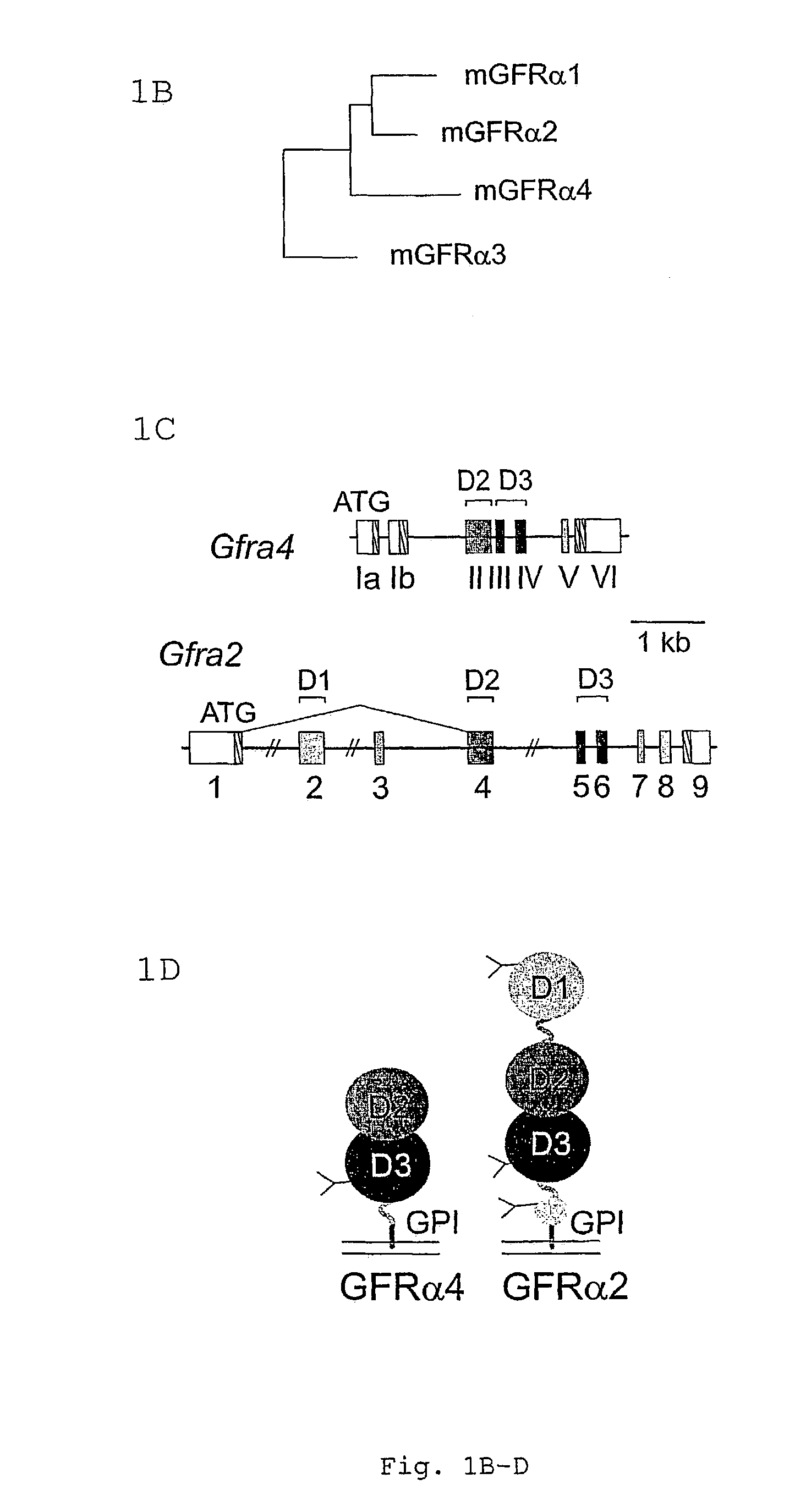Compounds related to or derived from GFR alpha4 and their use
a technology of compound and ligand, applied in the direction of growth factor/regulator receptors, drug compositions, peptides, etc., can solve the problem that the ligand-specificity of mammalian gfr4 cannot be directly extrapolated from experiments with chicken gfr4
- Summary
- Abstract
- Description
- Claims
- Application Information
AI Technical Summary
Benefits of technology
Problems solved by technology
Method used
Image
Examples
example 1
[0174]Several putative exon sequences homologous to known Gfra genes were identified by BLAST analysis of a 47887 bp sequence containing the putative mouse Gfra4 locus (Gunn et al., 1999) (Genebank accession number AF155960). Database search using these sequences as query detected three mouse expressed sequence tags (ESTs) matching the 3′ end of the putative Gfra4 gene (AA823200 or AI1553571, a spliced EST from mammary gland; AU035938, an unspliced one from the brain; and AI845209 a short one from the spinal cord). Nucleotide and amino acid sequence comparisons (BestFit), alignment (PileUp), and phylogenetic tree (GrowTree), as well as signal sequence and transmembrane hydrophobicity plots (PeptideStructure) were analyzed using the SeqWeb program package (Genetics Computer Group, Inc.).
example 2
RACE Cloning
[0175]cDNA clones representing the 5′-region of Gfra4 transcript were isolated from adult mouse brain, testis and thyroid gland, as well as from E17 embryo, using the 5′-RACE System (Life Technologies) and the GC-RICH PCR kit (Roche) according to the manufacturer's instructions. Total RNA was extracted with Trizol reagent (Life Technologies). The anti-sense Gfra4 specific primers used in 5′ RACE were: 5′-TTC AGC TCA GTG AGC AGT CAT CG-3′ (SEQ ID NO:18:) and second nested primer 5′-CAG GTT GTC CAG GTA GTT GG-3′ (SEQ ID NO:19:) or 5′-CAT CGT GCC ACG TAC TCA GA-3′ (SEQ ID NO:20:). The 3′ region of the Gfra4 was cloned with 3′RACE method using Clontech Marathon Ready cDNA from E15 mouse embryos according to the manufacturer's instructions. The primers used in 3′-RACE were: 5′-TAC AAG CCT TTG ACA GCT TGC AGC-3′ (SEQ ID NO:21:) and a nested one 5′-AGA GCT GGA GGC AGA AAC AGT CC-3′ (SEQ ID NO:22:).
[0176]Human GFRA4 cDNAs were identified from a human thyroid cDNA (Clontech Marat...
example 3
Northern Blot and Reverse Transcription (RT)-PCR
[0177]Norther blot analysis of Gfra4 expression was carried out from total RNA essentially as described (Rossi et al., 1999). Analysis of the splicing pattern of Gfra4 was performed by RT-PCR using Superscript II (Life Technologies) for RT and the GC-RICH PCR kit (Roche) for PCR. The following primers were used (see FIG. 2C): P1, 5′-CCA CCA TGG CCC ACT GCA TGG AGTC-3′ (SEQ ID NO:23:); P2, 5′-CCA CCA TGT TGA GAA GAG CA-3′ (SEQ ID NO:24:); P3, 5′-GTG TAC AGC AGA CGA GCG GT-′3′ (SEQ ID NO:25:); P5, 5′-ATA CAA GCC TTT GAC AGC TTG C-3′ (SEQ ID NO:26:); and reverse primers P4, 5′-GTT CCT TGT AAA GAG CTT GCG-3′ (SEQ ID NO:27:); and P6, 5′-TGG ACA AGA TGC CTA CTG ACG-3′ (SEQ ID NO:28:). The amounts of total RNA was run 35-40 cycles using annealing temperatures of 55-58° C. All the PCR products of different length were sequenced to verify their identity.
PUM
| Property | Measurement | Unit |
|---|---|---|
| dissociation constant | aaaaa | aaaaa |
| dissociation constant | aaaaa | aaaaa |
| temperatures | aaaaa | aaaaa |
Abstract
Description
Claims
Application Information
 Login to View More
Login to View More - R&D
- Intellectual Property
- Life Sciences
- Materials
- Tech Scout
- Unparalleled Data Quality
- Higher Quality Content
- 60% Fewer Hallucinations
Browse by: Latest US Patents, China's latest patents, Technical Efficacy Thesaurus, Application Domain, Technology Topic, Popular Technical Reports.
© 2025 PatSnap. All rights reserved.Legal|Privacy policy|Modern Slavery Act Transparency Statement|Sitemap|About US| Contact US: help@patsnap.com



